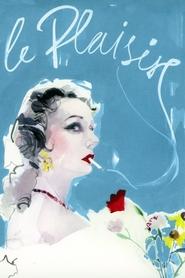Happiness is no lark.
The beauty and Mozartian sense of visual musicality of his work enhance rather than detract from Ophüls’s toughness, for, beneath the velvety suavity, the director’s worldview could be as bleak, savage even, as those of fellow Teutonic masters Von Stroheim, Lang, Wilder, and Preminger. […] Amid the festivities [of Le Masque], a man decked in tuxedo, top hat, monocle, and mustache, virtually a parody of the dapper gentleman, rushes onto the dance floor to join the quadrille; in one of the most stunning of all tracking shots, Ophüls’s camera follows his strenuous pirouettes until the mysterious figure collapses. The camera movement […] accentuates the character’s loss of control, like a puppet getting tangled over his own strings. […] [In the second episode, La Maison Tellier,] Ophüls slyly hints that gender exploitation has become so ingrained into society that the cathouse is essential to keeping stability; on the Saturday night that the doors are closed, fights break out among men as the respectable pillars of society line up by the shore to bitch and moan. […] The third segment, Le Modèle, is necessary for the crystallization of the previous themes, and for the final dissection of the nature of pleasure [ — with both] legs broken, she forces Gélin into marriage, a grotesque victory that, paradoxically, seals her freedom. In a society built on the oppression of a gender, where pleasure is not only ephemeral but one-sided, Ophüls says, female assertion can only erupt through such dreadful acts of revolt.
— Fernando F. Croce (Slant Magazine)
Synopsis: Three stories about the pleasure. The first one is about a man hiding his age behind a mask to keep going to balls and fancying women - pleasure and youth. Then comes the long tale of Mme Tellier taking her girls (whores) to the country for attending her niece's communion - pleasure and purity. And lastly, Jean the painter falling in love with his model - pleasure and death.

